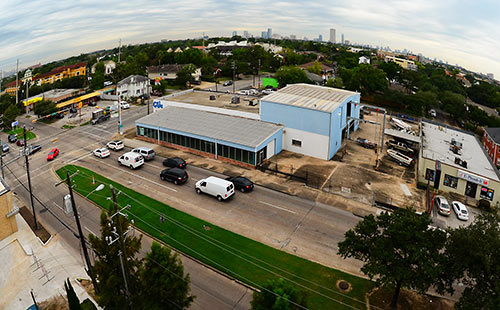COMMENT OF THE DAY: NARROW THE STREETS TO MAKE NON-DRIVERS SAFER  Looks like Montrose Blvd. needs some work—unsurprising, given it’s a street with a lot of combined foot and vehicle traffic, while being extremely wide with few obstructions to get motorists to slow down. Notice that Westheimer has fewer incidents even though it’s an even busier street with a lot more foot traffic. It will probably never happen, but Montrose Blvd. could really benefit safety-wise from much narrower lanes, and bike lanes and on-street parking substituted instead. It certainly has the space to do it, especially if you subtract the center turn lane in some places. [Christian, commenting on Your Map of Where Walkers and Bikers Have Been Run Over by Cars in Houston Over the Past 2 Years] Photo of Montrose Blvd. at W. Gray St.: Andrew Steffler [license]
Looks like Montrose Blvd. needs some work—unsurprising, given it’s a street with a lot of combined foot and vehicle traffic, while being extremely wide with few obstructions to get motorists to slow down. Notice that Westheimer has fewer incidents even though it’s an even busier street with a lot more foot traffic. It will probably never happen, but Montrose Blvd. could really benefit safety-wise from much narrower lanes, and bike lanes and on-street parking substituted instead. It certainly has the space to do it, especially if you subtract the center turn lane in some places. [Christian, commenting on Your Map of Where Walkers and Bikers Have Been Run Over by Cars in Houston Over the Past 2 Years] Photo of Montrose Blvd. at W. Gray St.: Andrew Steffler [license]





“Photo of Montrose Blvd. at Taft St.”
Hate to nitpick but there is no such place.
Montrose and Taft run parallel to one another and several blocks apart.
I would not label Montrose as “extremely wide”; if there were room I would suggest making it wider. Also, I would be against narrowing any streets in Houston. It is a growing city and the majority of people here use cars and buses to get from place to place. On a related note, I think that project to narrow streets downtown and add head-in parking was a huge mistake. It creates gridlock at times and the spaces are difficult and risky to back out of.
Am I mistaken, or is the proposal here to reduce traffic flow on montrose to allow for more mixed pedestrian usage? Do we really want to intentionally divert more commercial/commuter traffic through residential areas?
.
The problem with westheimer is that because of it’s reduced traffic flow inside shepherd a lot of parallel streets like fairview and vermont that are not made to support the same levels of traffic see higher usage rates thus imposing greater danger in the neighboring residential areas.
.
Montrose has fewer alternate options for N-S commuter traffic which I’ve always found to be far far greater than E-W commuter traffic. Anyone have numbers on this?
.
We just gave up and moved out of montrose for the kid. Tired of having parks close by that take forever to walk to and feel like i’m endangering the kiddo. Far better/easier places to find walkability in town rather than trying to stick it out in the trose.
joel: Interesting, before I moved out of Houston, we loved living in Montrose (Westmoreland to be specific) with our kid. Lots of little parks to walk to. Lots of places to eat to walk to. Even groceries were waking distance (save when my wife would want to go to Central Market)
Bill, I’m curious. How could you widen Montrose Blvd without tearing down private property? At what point do we realize that there is a limit to expanding car capacity on our roads, and try something else for moving people around?
Overall, I’m in agreement with Houstonreader – the cost to take over private property to widen Montrose Boulevard would be too much. Then, you’d have to add in the cost of actually building and maintaining that new addition.
.
All so that we can shove more cars, trucks, and buses on it – and then repeat the gridlock all over again. There is no magic bullet really: we have to encourage people to take public transit or ride-share, have increased density by building vertically, and yet make this new zone palatable to living there. A difficult trifecta to achieve that will take a lot of money, time, and patience. Usually one of those three runs out well before the others.
Montrose is already traffic nightmare during rush hour – reducing the lanes without adding any other improvements is a non-starter.